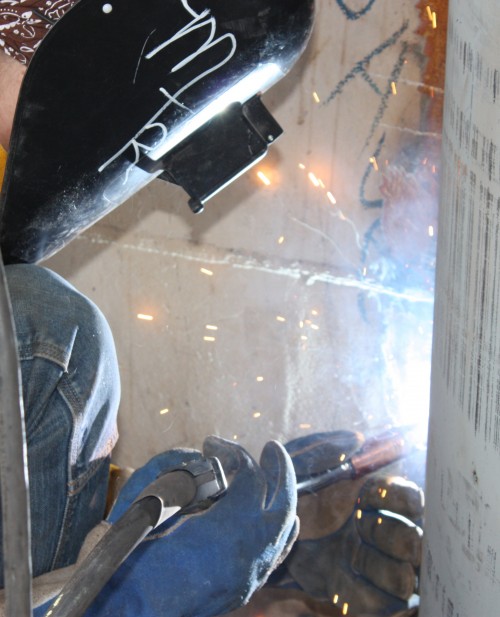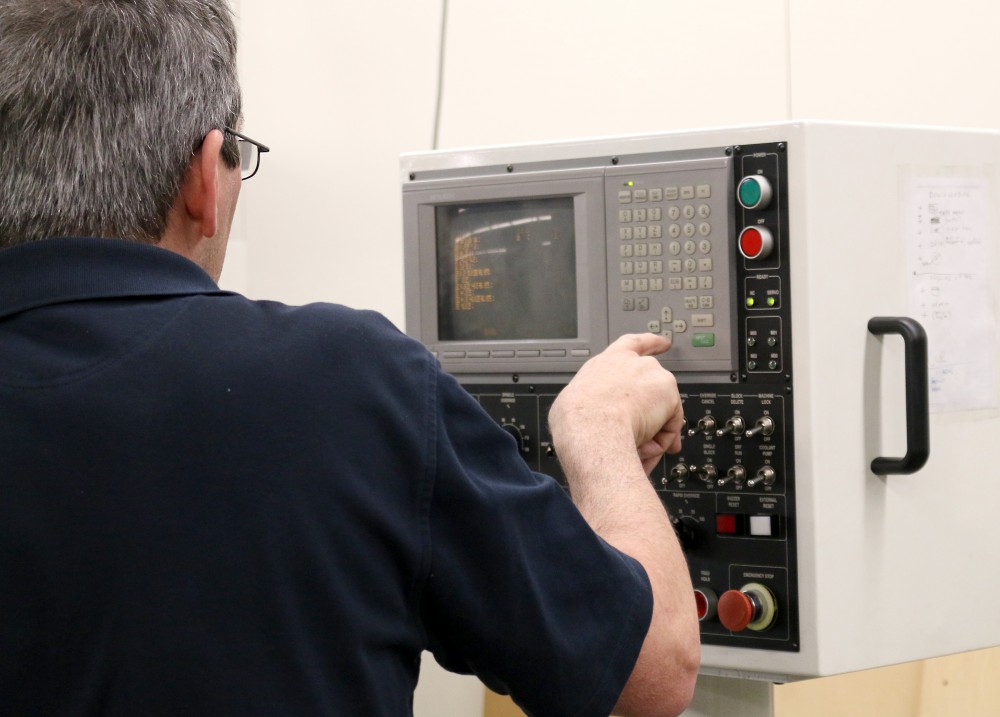This content was published: March 3, 2016. Phone numbers, email addresses, and other information may have changed.
Oregon Legislature earmarks $7.5 million for Advanced Manufacturing Research Center
Photos and Story by Kate Chester
Big news came out of the Oregon Legislature with the announcement of $7.5 million to be appropriated for the creation of an Advanced Manufacturing Research Center (AMRC).
The facility will be located in Columbia County. The project, built on the synergy of regional industry, academia and government stakeholders, is based in part on an AMRC apprenticeship model developed by Boeing and the University of Sheffield in England to address critical manufacturing challenges through applied research and advanced technical training.
The state’s investment will be added to $9.4 million in bonding authority from Portland Community College to support educational opportunities in Columbia County, for a total investment of nearly $17 million. Additional sources of financial support potentially include private and public investors and federal grants.
“This is an investment not just in high tech manufacturing, but in our workforce, in regional job growth, and our state’s economic future,” said Gov. Kate Brown. “Today we are taking an important step forward, developing a world-class community where instruction, research, design, and manufacturing intersect for the benefit of all.”
Initial efforts will focus on training for students through industry-sponsored skilled apprenticeships that lead to postsecondary credentials and family-wage jobs. This will be led by PCC as the educational accrediting partner. Advanced manufacturing research activities will be led by local university and research partners such as Oregon State University, Portland State University and the Oregon Institute of Technology.
“As the state’s largest higher education and workforce training institution serving a five-county region, Portland Community College is thrilled to collaborate with a consortium of local partners to support this transformational opportunity,” said Sylvia Kelley, interim president of PCC.
 “The project’s potential is tremendous, and we are very grateful for the support of it by the Governor and state legislators,” she said.
“The project’s potential is tremendous, and we are very grateful for the support of it by the Governor and state legislators,” she said.
Additional stakeholders and potential partners include Boeing and other regional metals manufacturers, the Oregon Employment Department, the Bureau of Labor and Industries, the AFL-CIO, Greater Portland Inc., the Oregon State Building and Construction Trades Council, the International Association of Machinists and Aerospace Workers and IBEW 48.
Collectively, efforts to create a local AMRC will facilitate the long-term goal of developing an “Oregon Manufacturing Innovation District” in which stakeholders share costs and pool resources and attract potential new partners. Long term, project partners anticipate this leading to high-value manufacturing companies and their supply chains co-locating, resulting in significant impact to and vitality for Oregon’s economy.
Such collaboration among stakeholders also meets industry needs. Data indicates that the skilled metals workforce throughout the United States, including here in Oregon, is aging into retirement at a time when manufacturers are forecasting significant growth in demand. Already employers are experiencing labor shortages; they anticipate an even greater void as employees retire, so the need to create a pipeline of trained workers is critical.
“This project presents an exciting opportunity for Boeing and other industry partners,” said Mike Starr, general manager, Boeing Oregon, which employs more than 1,650 staff who oversee complex machining and building of gear systems and flight controls. “The potential coalition could create the means to provide highly trained workers for the region’s metals industry, a field whose workforce is shrinking due to retirement.
“Several partners are coming together to problem-solve at the same time they’re creating opportunity for students and industry through training, research and development. It’s a fantastic approach, and we’re very supportive of it,” he said.
Boeing has experience creating successful AMRCs with willing partners. Its first was in 2001 in Sheffield, England, in collaboration with the University of Sheffield. Together, the partners transformed a 400-acre empty lot in a depressed region of the country into a renowned manufacturing center that today employs 2,000 engineers and apprentices, assists 500 manufacturing companies with training and innovation, and has had a $1 billion impact on the economy.
Since then, numerous centers worldwide have been successfully replicated from this model. The goal is to produce a similar outcome in Oregon supported by a variety of partners.
“Launching a successful AMRC in Columbia County will be the catalyst for advances in manufacturing technology that will significantly benefit manufacturers throughout our region,” said State Sen. Betsy Johnson who represents Senate District 16, which includes Columbia County.
“It also becomes a magnet to attract other manufacturing entities to our state. That’s an incredible value proposition,” she said.
This reaction echoes the sentiment of those representing skilled workers in metals industries here in Oregon.
“The Machinists Union is a strong supporter of this endeavor, one we believe will advance our trade and positively accelerate the scope of Oregon’s workforce,” said Noel Willet, ADBR, IAM District W24.
“Creating apprenticeship and training programs is key to attracting new business and family wage jobs. And it’s crucial that we all work together to create a dynamic workforce with the additional skills required as manufacturing advances through research,” he said.
The role of research and development is critically important to this venture. To remain competitive, companies need to transition technology and hire qualified personnel. Those being trained in association with research enter the workforce with both current, pertinent skills and an awareness of advances being made in the field. Synergy is created: Workers have access to progressive training, and training and research facilities stay current and contribute to the health of the economy.
Local universities – OSU, PSU and OIT – will be instrumental in this effort, leading collaborative research and development that bolsters economic growth and deepens relationships with metals-related industries as it pertains to enhanced technology.“I visited England in late January and saw for myself the AMRC operations at the University of Sheffield,” said Chris Maples, president of OIT. “This kind of model offers huge potential for research, innovation and business development once replicated here in Oregon. It’s phenomenal, really, to think of what the future might hold.”
Oregon State University President Ed Ray weighed in, as well.
“We appreciate this legislation as it helps our community college partners develop a skilled workforce that is critical to attracting and retaining industry within our state,” Ray said. “As the Oregon Manufacturing Innovation District takes shape, OSU looks forward to continued applied research with firms engaged in manufacturing to enable their competitive success and grow the state’s economy.”
Added Wim Wiewel, PSU’s president, “Oregon has the right ingredients for a model of this kind to take off: willing, proactive research and educational partners, established precision manufacturing companies and support from government.”
Next steps for PCC and collaborating partners include nurturing workforce development relationships with local metals manufacturers and developing curricula for industry-supported apprenticeships.
“A center like this enables us to bring together experienced teams who lend capital investment, equipment and expertise, and funnel that support to benefit students we’re educating and training for jobs in an industry that offers growth and opportunity,” said Kelley.
“The Advanced Manufacturing Research Center model has a proven track record, and it’s exciting to think of how much Oregon stands to benefit by creating one here,” she said.



I hope that we will see public transportation improvements to support this fine initiative. We need regular and frequent passenger rail and bus service linking Columbia County towns to each other and to transit hubs in Portland and Beaverton.
We currently have CC Rider and Hwy 30 for transportation. As the economy improves in Columbia County so will public transportation. Senator Betsy Johnson deserves a great big thank you.
This is exciting stuff! Good news for Columbia County and the region, for manufacturers and people demanding family-wage jobs alike. Let’s make sure that what and where we build takes environmental impact into the highest consideration.
This is wonderful news! So exciting and what an grand opportunity for all involved!
[…] Community College has announced it has named a temporary director for the new Oregon Manufacturing Innovation Center (OMIC), a world-class facility that will pair advanced manufacturing research and trades-based […]